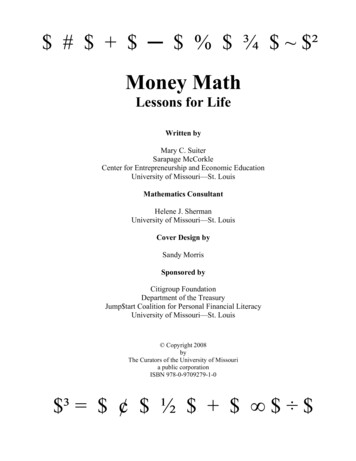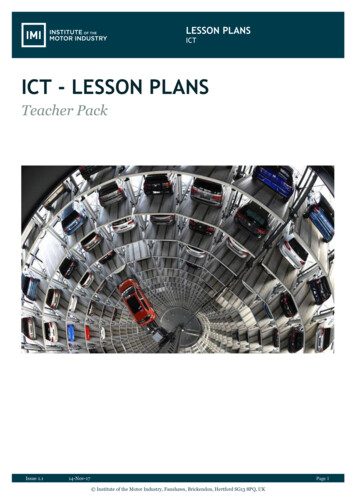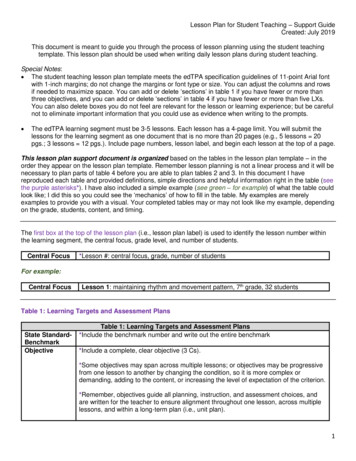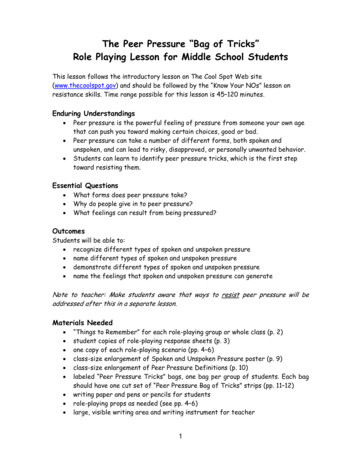
Transcription
# % ¾ ²Money MathLessons for LifeWritten byMary C. SuiterSarapage McCorkleCenter for Entrepreneurship and Economic EducationUniversity of Missouri—St. LouisMathematics ConsultantHelene J. ShermanUniversity of Missouri—St. LouisCover Design bySandy MorrisSponsored byCitigroup FoundationDepartment of the TreasuryJump tart Coalition for Personal Financial LiteracyUniversity of Missouri—St. Louis Copyright 2008byThe Curators of the University of Missouria public corporationISBN 978-0-9709279-1-0 ³ ½
Money Math: Lessons for LifeLesson 1The Secret to Becoming a MillionaireLessonDescriptionStudents learn how saving helps people become wealthy. Theydevelop “rules to become a millionaire” as they work through aseries of exercises, learning that it is important to: (1) save earlyand often, (2) save as much as possible, (3) earn compound interest,(4) try to earn a high interest rate, (5) leave deposits and interestearned in the account as long as possible, and (6) choose accountsfor which interest is compounded often. This lesson assumes thatstudents have worked with percents and decimal equivalents.ObjectivesStudents will be able to:1. define saving, incentive, interest, and opportunity cost.2. solve problems using interest rate, fractions, decimals, andpercentages.3. calculate compound interest.4. explain the benefits of compound interest.5. explain the opportunity cost of saving.6. describe a savings bond investment.MathematicsConceptspercent, decimal, data analysis, number sense, solving equations,problem solvingPersonal FinanceConceptsinterest, interest rate, compounding, wealth, saving, savings,inflation, purchasing powerMaterialsRequired copies of Activities 1-1 through 1-5 for each student transparencies of Visuals 1-1 through 1-7 calculator for each student computersTime Required4 - 6 daysProcedureGet Ready1. Ask the following. Do you want to be a millionaire? What is amillionaire? Explain that a millionaire is a person who haswealth totaling one or more million dollars, noting that wealthis the total value of what a person owns minus what he or sheowes. How could you become a millionaire? (win the lottery,win a sweepstakes, inherit a million dollars, earn a highincome) Read the following scenario to the class.Money Math: Lessons for Life (Lesson 1) Copyright 2008 by The Curators of the University of Missouri, a public corporationReproduction is permitted and encouraged.1
The Secret to Becoming a MillionaireMoney Math: Lessons for LifeLesson 1Last week, Mrs. Addle told her students that they couldbecome millionaires if they followed the rules sheprovided them. As a matter of fact, she guaranteed that ifthey followed her rules exactly, they would be millionairesin 47 years! Misha and the rest of her classmates thoughtthat Mrs. Addle was crazy. If she had rules that wouldguarantee that someone could be a millionaire, why wasshe teaching seventh-grade math? Why wasn’t she richand retired? Why didn’t she follow her own rules? Mrs.Addle told the students to go home and talk to theirfamilies about what she had said.Misha went home and told her family what Mrs. Addlehad said. Misha’s mother knew a lot about money andfinancial matters. She just smiled at Misha and said thatMrs. Addle was correct. When Misha returned to classthe next day, Mrs. Addle asked what the students’ familiessaid. Of the 25 students in Mrs. Addle’s class, 20 studentssaid that their parents and other family members agreedwith Mrs. Addle. The other five students forgot to ask.2. Explain that to learn more about being a millionaire, thestudents must review what a percent is. (Note: If needed,Visual 1-1 includes a review.)3. Point out that in the story, there are 25 students in Misha’sclass, and 20 students discovered that their families agreed withMrs. Addle. Ask the following questions. (Note: Step-by-stepcalculations are provided on Visual 1-2.)a.b.What percent of the students’ families thought that Mrs.Addle was correct? (80%)What percent of the students failed to do their homework?(20%)Get Going1. Explain that you will share Mrs. Addle’s secrets with them.When they become millionaires, they can donate money to theschool’s math department! Discuss the following.Money Math: Lessons for Life (Lesson 1) Copyright 2008 by The Curators of the University of Missouri, a public corporation2Reproduction is permitted and encouraged.
Money Math: Lessons for LifeLesson 1a.b.c.d.The Secret to Becoming a MillionaireHow do you earn income? (mow lawns, baby-sit, walkpets, rake leaves, do chores around the house)What do you do with your income? (save it, spend it,save some and spend some)Why do you spend your income? (to buy things that theywant now, such as movies, food, and clothes)Why do you save your income? (to buy things they wantin the future)2. Explain that when people earn income, they can spend it or saveit. When they are spending, they spend their money today forgoods and services, but they give up the chance to use thatmoney to buy goods and services in the future. When saving,they give up goods and services now to have other goods andservices in the future. When people make choices, the highestvalued alternative choice that is given up is their opportunitycost. Read the following scenario.Next year, you want to take a family and consumer scienceclass, a woodworking class, and a photography class.However, you only have room in your schedule for one of thesethree. Which would you choose? What would be your secondchoice?3. Have several students share their first and second choices.Explain that their second choice is their opportunity cost—it isthe highest-valued alternative class. When people save, thegoods and services that they would have purchased now—thehighest-valued alternative—represent their opportunity cost.When they spend now, their opportunity cost is goods andservices they could have in the future.4. Assign Activity 1-1. When they are finished, have studentsshare answers. (1. 360, 720, 1080, 1440, 1800, 2160; 2.The items they would have purchased each day with 2. This istheir opportunity cost. 3. A (B x 180) where A previousyear balance and B the amount deposited each day; 4. Savemore each day.) Point out that students have differentopportunity costs because their tastes and priorities are different.Money Math: Lessons for Life (Lesson 1) Copyright 2008 by The Curators of the University of Missouri, a public corporationReproduction is permitted and encouraged.3
The Secret to Becoming a MillionaireMoney Math: Lessons for LifeLesson 15. Display Visual 1-3. Have students deduce what has changed ineach case. They should develop Rules 1 and 2 to become amillionaire. (In the first case, the saver is saving for a longerperiod; therefore, Millionaire Rule 1 is to start saving early. Inthe second case, the saver is saving 4 per day instead of 2 perday; therefore, Millionaire Rule 2 is to save more or to save asmuch as possible.) Write the two rules on the board.6. Discuss the following.a.b.c.How many of you have savings accounts in banks?(Answers will vary.)What are the benefits of placing your savings in a bank?(The money is safe in the bank, and the bank paysinterest.)What is interest? (Students may or may not know theexact definition of interest.)7. For homework, students who have savings accounts may bringin a statement from their savings accounts. Have all studentslook for ads in local newspapers and listen to television andradio ads about banks. Tell them to write down any informationabout interest rates.Keep It Going1. Assign Activity 1-2. Allow students to share their answers. (1. 396, 831.60, 1310.76, 1837.84, 2417.62, 3055.38; 2.(A 360) [(A 360) x .10] where A is the previous year’sending balance, or, 1.10 (A 360); 3. These amounts are higherbecause they earn interest on the deposit and interest on theinterest earned in previous years.)2. Point out that the 10% amount that Uncle Mort pays is anincentive. An incentive is a reward that encourages people tobehave in a particular way. This incentive encourages people tosave and keep their savings. How much of an incentive didUncle Mort pay the first year? ( 360 x .10 36)3. Explain that banks provide an incentive for people to save.When people make deposits to savings accounts, banks are ableto use the money to loan to others. In return, the banks payMoney Math: Lessons for Life (Lesson 1) Copyright 2008 by The Curators of the University of Missouri, a public corporation4Reproduction is permitted and encouraged.
Money Math: Lessons for LifeLesson 1interest to savers. Interest is a payment for the use of money.Bankers don’t usually tell people that they will earn a specificsum of money. Savers are told the interest rate to be received.The interest rate is the annual interest payment on an amountexpressed as a percentage. For example, a bank might pay a 4%interest rate on a savings account. Uncle Mort pays 10%.Teaching Tip:Show students how just alittle bit of money can addup to a lot of cash withcareful saving andinvesting. Ask yourstudents to save theirpocket change for onemonth.Assuming your studentssave 1 a day, theyshould have 30 after onemonth of saving. If yourstudents invest 30 worthof change every month for10 years, how much moneywill they have if they investtheir money in thefollowing ways: Savings account with a2% annual rate of return Money market fund witha 5% annual rate of returnThe Secret to Becoming a Millionaire4. Write the word “compounding” on the board. Ask studentswhat they think this word means and how it applies to becominga millionaire. Allow students to look the word up in thedictionary and in newspaper advertisements. Guide students torecognize that leaving interest earned on savings in the savingsaccount so that the saver earns interest on the original depositand interest on the interest is called earning compound interest.Have students develop Millionaire Rule 3 and write it on theboard. (Earn compound interest.)5. Explain that banks pay compound interest on savings, althoughit may not be as much as Uncle Mort pays. Discuss thefollowing. Mutual fund with a 9%annual rate of returna.What can your studentsbuy with this money? Willit be enough to purchase acar when they turn 22?b.Give examples of the interest rates local banks are payingfrom the statements, ads, and ad information brought fromhome. (Answers will vary; however, the rates are likely tobe much lower than the 10% that Uncle Mort pays.)What would happen to the amount of accumulated savingsif Uncle Mort paid only 5%? (It would be less.)6. Display Visual 1-4. Explain that this table illustrates whatwould happen if a bank paid 5% interest compounded annually.Point out that comparing the savings results at 5% with thesavings results for 10% ( 2571.12 at 5% compared to 3055.78 at 10%) gives us another rule for becoming amillionaire. Discuss the following.a. Based on the comparison between accumulated savingswith 5% interest and with 10% interest, what is the fourthrule of becoming a millionaire? (Try to earn a highinterest rate.) Add this rule to the list on the board.b. What would happen to accumulated savings if thedeposits and interest were left in the account, earning 5%interest for another six years? (It would increase.)Money Math: Lessons for Life (Lesson 1) Copyright 2008 by The Curators of the University of Missouri, a public corporationReproduction is permitted and encouraged.5
The Secret to Becoming a Millionairec.Money Math: Lessons for LifeLesson 1What is the fifth rule of becoming a millionaire? (Leavedeposits and interest in the account for as long aspossible.) Add this rule to the board.7. Have students consider how they used their calculators to solvethese problems. Guide them to develop a recursive equationsuch as [ANS 0.05(ANS)] ending balance for each year or[ANS 0.05(ANS)] 360 beginning balance for eachsuccessive year.8. Review the basic rules for becoming a millionaire. Write thefollowing rules on the board.(1) Save early and often.(2) Save as much as possible.(3) Earn compound interest.(4) Try to earn a high interest rate.(5) Leave deposits and interest in the account as long aspossible.Graph It (Optional)1. Tell students they will create four line graphs on the same setof axes. These graphs should show the amount of savingsearned over time: (a) when saving 360 per year for six yearsin a bank, (b) when saving 360 for 10 years in a bank, (c)when saving 720 per year for six years, and (3) when saving 360 per year for six years at a 5% interest rate per year. Theydetermine the dependent and independent variables and labelthe axes appropriately. They should retain these graphs forlater use. They may use a graphing calculator, a computer, orpaper and pencil to create the graphs.2. Have students create a circle graph that shows the percent oftotal savings that resulted from deposits by the saver and thepercent that resulted from compound interest when saving 360per year for six years at a 5% interest rate. They may use agraphing calculator, a computer, or paper, pencil, and aprotractor.Money Math: Lessons for Life (Lesson 1) Copyright 2008 by The Curators of the University of Missouri, a public corporation6Reproduction is permitted and encouraged.
Money Math: Lessons for LifeLesson 1The Secret to Becoming a MillionaireCheck It AssessmentDisplay Visual 1-4, and assign Activity 1-3 to each student. Whenstudents are finished, display Visual 1-5 so they can check theiranswers.Keep Going1. Have students refer to the savings account and advertisementinformation they brought from home. Discuss the following.a.b.c.d.Do the ads or account statements tell consumers that theinterest rate is compounded annually? Semi-annually?Quarterly? (Answers will vary.)What do you think these terms mean? (annually - onceper year; semi-annually - twice per year; quarterly - fourtimes per year)How do you think semi-annual or quarterly compoundingmight affect accumulated savings? (Answers may vary.)How do you think quarterly interest payments would becalculated? (Answers may vary.)2. Assign Activity 1-4 to groups of 4 or 5 students. Tell thegroups to work together to complete the activity. DisplayVisual 1-6 to check and correct their answers.3. Display Visual 1-4 again. Ask students to compare this tablewith the quarterly compounding table they completed. Discussthe following.a.b.c.d.e.What was the total amount deposited by the saver in eachcase? ( 2160)How much interest was earned with interest compoundedannually? ( 411.12)How much interest was earned with interest compoundedquarterly? ( 419.54)How much additional interest was earned throughquarterly compounding? ( 8.42)What do you think would happen if interest werecompounded daily? (more accumulated savings at theend of the year)Money Math: Lessons for Life (Lesson 1) Copyright 2008 by The Curators of the University of Missouri, a public corporationReproduction is permitted and encouraged.7
The Secret to Becoming a Millionairef.Teaching Tip:Be sure to tell yourstudents that people puttheir savings in manyplaces. Many peoplechoose to invest theirsavings in stocks. Buyingstocks means buying someownership (equity) in acompany. On average,over time, stocks haveearned higher returns thansavings accounts.Stockholders receivereturns from dividends (aportion of business profitpaid to stockholders) andcapital gains (the amountof the sale of stock thatexceeds the original pricepaid by the stockholder).Tell students to look at thestock tables in the financialpages of a newspaper.Point out that the yield(Yld.) is the return fromdividends stated as apercentage. Have studentscompare the dividend yieldto interest rates on savingsaccounts. Then, point outthat most stock investorsare interested in capitalgains; that is, the increasedvalue of the stock from thetime it was purchased.Have students researchhow much stocks, onaverage, have increasedover time. Information onthe growth of the S&P 500can be found by searchingfor S&P 500 History on theinternet.Money Math: Lessons for LifeLesson 1What is the sixth and final rule for becoming amillionaire? (Deposit money in accounts for whichinterest is compounded most often.) Add the rule to thelist on the board.4. Review all rules to becoming a millionaire.(1)(2)(3)(4)Save early and often.Save as much as possible.Earn compound interest.Leave deposits and interest in the account for as long aspossible.(5) Try to earn high interest rates.(6) Choose accounts for which interest is compounded often.Compute It1. Divide students into pairs. Explain that their task is to discovercombinations of interest rate, deposit, and years of savings thatwill lead to the goal of becoming millionaires. They may use afinancial calculator, spreadsheet financial functions on thecomputer, or use a financial calculator on a bank’s website.2. Once they have decided what program to use, they should entervarious combinations of deposit amounts, interest rates, yearsof saving, and how often interest is compounded and note theimpact on accumulated savings.3. Have student pairs share the combinations with which theywould be happiest. Discuss whether these combinations arerealistic with questions such as “Is it reasonable to expect aninterest rate of 20%?” or “What amount of monthly income doyou think a person must earn in order to save 3000 permonth?”Wrap It UpDiscuss the following to highlight important information.1. What does a percentage represent? (some part of a hundred)Money Math: Lessons for Life (Lesson 1) Copyright 2008 by The Curators of the University of Missouri, a public corporation8Reproduction is permitted and encouraged.
Money Math: Lessons for LifeLesson 1The Secret to Becoming a Millionaire2. How can 55% be expressed as a decimal? (.55) a fraction?(55/100)3. What is interest? (payment for the use of money)4. What is an interest rate? (the annual interest payment on anaccount expressed as a percentage)5. What is compounding? (paying interest on previous interest)6. What is saving? (income not spent today to be able to buygoods and services in the future)7. What is opportunity cost? (the highest-valued alternative thatis given up)8. What is the opportunity cost of saving? (goods and servicesgiven up today)9. What are some rules about saving that can help you become amillionaire? (Start saving early and save regularly. Save asmuch as you can. Earn compound interest. Leave the depositand interest earned in the account as long as possible. Try toearn a high interest rate. Seek savings options that compoundinterest often.)Check It/Write It AssessmentExplain that students’ work with the computer or calculator helpedthem see the impact of the various rules on the quest to become amillionaire. Divide the students into small groups and tell them toanswer the following questions in writing, as a group.1. What happens to accumulated savings if the deposit amountincreases? (Savings would increase. Saving larger amountsgenerates greater savings in the future.)2. What happens to accumulated savings if the interest rateincreases? (It would increase.)3. What happens to accumulated savings if the number ofcompounding periods per year increases? Why? (It wouldincrease because every time compounding occurs, the saver isearning interest on interest earned.)4. What happens to accumulated savings if the number of yearsincreases? (It would increase.)5. What is the key to becoming a millionaire? (Save as much aspossible for as long as possible earning a high interest ratethat is compounded frequently.)Money Math: Lessons for Life (Lesson 1) Copyright 2008 by The Curators of the University of Missouri, a public corporationReproduction is permitted and encouraged.9
The Secret to Becoming a MillionaireMoney Math: Lessons for LifeLesson 1Going Beyond A Challenge Activity1. Remind students that one of the important rules about saving isto try to earn a high interest rate. To do that, savers mustinvestigate various savings options available. If people save ina piggy bank, they don’t earn any interest on their savings, andit isn’t particularly safe. If people place their savings in asavings account at the bank, they earn interest and it is usuallysafe because of deposit insurance. However, the interest rate isusually lower on these accounts than some other savingsoptions.2. Explain that people can put their money in a certificate ofdeposit or CD. A certificate of deposit is a savings account thatpays higher interest than a regular bank savings account.However, when people put their money in a CD, they promiseto leave the savings in the account for a certain amount of time,such as six months, a year, or five years.3. Explain that many people save by buying savings bonds issuedby the United States government. When people buy a savingsbond, they are lending money to the government to helpfinance programs or projects. Savings bonds come in differentdenominations, such as 50, 100, or 500. They areconsidered to be a very safe way to save money; that is, theyare virtually risk-free.4. Point out that the newest type of U.S. savings bond is the IBond. I Bonds are inflation-indexed and designed for saverswho want to protect themselves from inflation. Defineinflation as an increase in the average level of prices in theeconomy. (A simpler definition is an increase in most prices.)5. Explain that inflation reduces the purchasing power of savings.Purchasing power is the ability to buy things with an amountof money. People save because they want to buy things in thefuture. If they can buy a certain amount of things with 1000today, people want to be able to buy at least the same things inthe future with their savings. Discuss the following.Money Math: Lessons for Life (Lesson 1) Copyright 2008 by The Curators of the University of Missouri, a public corporation10Reproduction is permitted and encouraged.
Money Math: Lessons for LifeLesson 1The Secret to Becoming a Millionairea.If you saved 1000 today to buy a 1000 computer nextyear, would you be able to buy it if your savings earned5% and the price of the computer stayed the same? (Yesbecause you’d have approximately 1050 to buy the 1000 computer.)b. If you saved 1000 today to buy a 1000 computer nextyear, would you be able to buy it if your savings earned5% and the price of the computer increased 3%? (Yesbecause you’d have approximately 1050 to buy thecomputer that would cost 1030.)c. If you saved 1000 today to buy a 1000 computer nextyear, would you be able to buy it if you savings earned5% and the price of the computer increased 7%? (Nobecause you’d have approximately 1050 to buy thecomputer that would cost 1070.)6. Summarize by pointing out that inflation reduces thepurchasing power of accumulated savings. If people’s savingsare going to have the same purchasing power in the future, thenthe interest/earnings on the savings must be equal to or greaterthan the inflation rate. For example, if the inflation rate is 4%,then the interest rate must be at least 4% so the saver could stillbe able to buy the same amount of things in the future with themoney (principal).7. Explain that this is exactly what the inflation-indexed I Bond isdesigned to do—protect the purchasing power of anindividual’s principal AND pay fixed earnings. The I Bondinterest rate has two parts: a fixed interest rate that lasts for 30years and an inflation rate that changes every six months. Forexample, an I Bond may pay a fixed interest rate of 2%.Inflation may be measured at an annual rate of 3% for the firstsix months and 2.5% for the second half of the year. Thecombined interest rate for the first six months would be 2% 3%. The combined interest rate for the second half of the yearwould be 2% 2.5%.8. Give each student a copy of Activity 1-5, and assign. DisplayVisual 1.7 to check answers.Money Math: Lessons for Life (Lesson 1) Copyright 2008 by The Curators of the University of Missouri, a public corporationReproduction is permitted and encouraged.11
The Secret to Becoming a MillionaireMoney Math: Lessons for LifeLesson 1Check It Assessment1. Divide the students into small groups. Assign each group adifferent savings instrument. For example, money marketfunds, treasury bonds, treasury bills, savings accounts, andcertificates of deposits. Ask students to do some research toanswer the following questions.a.b.c.d.e.f.g.What is this savings instrument called?Does it require a minimum balance?Are there fees or penalties if you withdraw your moneybefore a specified time?Is this savings method more or less risky than savingsbonds?What is the interest rate on this savings instrument?Is interest compounded annually, semi-annually, quarterly,daily?How is the purchasing power of the savings protected frominflation?2. Tell students that each group must prepare a brief presentationin which they compare the advantages and disadvantages of thesavings instrument they researched with the advantages anddisadvantages of an I Bond.Money Math: Lessons for Life (Lesson 1) Copyright 2008 by The Curators of the University of Missouri, a public corporation12Reproduction is permitted and encouraged.
Money Math: Lessons for LifeActivity 1-1It’s Never Too LateSaving is income not spent now. The accumulated amount of money saved over aperiod of time is called savings. Suppose there are 180 days in a school year, and youbegin saving 2.00 each day in your bank beginning in the 7th grade. You save all themoney each year. Your bank fills up and you start saving in an old sock. Answer thefollowing questions.1. Calculate the amount of savings that you have at the end of each year. Please show yourwork on the back of this sheet. Record your answers for each year in the “SAVINGS”column of the table below.GRADE LEVELSAVINGS7th grade8th grade9th grade10th grade11th grade12th grade2. What would you have to give up each day in order to save 2.00? What do we call theitem you would give up?3. Write a formula to represent the calculations that you made for each year.4. According to the formula, what will happen if you increase B?Money Math: Lessons for Life (Lesson 1) Copyright 2008 by The Curators of the University of Missouri, a public corporationReproduction is permitted and encouraged.13
Uncle Mort Makes It BetterMoney Math: Lessons for LifeActivity 1-2Suppose that on the first day of eighth grade you receive the following message from UncleMort. “I am proud that you’ve been saving. I will pay you 10% on the balance that yousaved in the seventh grade and 10% on the balance of your saving at the end of each year.”You have 360 in your bank. Answer the following questions.1. Calculate how much money you will have at the end of each year. Show your work on theback of this page. Write your answers in the “SAVINGS” column in the table below.GRADE LEVELSAVINGS7th grade8th grade9th grade10th grade11th grade12th grade2. Write a formula to represent the amount of savings accumulated at the end of each year.3. How do the amounts you’ve calculated compare to your previous savings calculations?Why?Money Math (Lesson 1) Copyright 2008 by The Curators of the University of Missouri, a public corporation14Reproduction is permitted and encouraged.
Money Math: Lessons for LifeActivity 1-3The Miracle of Compounding1. Write the basic percent equation that you have used in this lesson to solve for the part ofthe whole. Use the variables a, b, and c, where a is the percent, b is the whole, and c isthe part of the whole.2. Read the following sentences. Write an appropriate formula to use to solve for thepercent of allowance spent OR the amount spent.Mary received her weekly allowance of 10.Mary used two one-dollar bills and two quarters.Mary spent one-fourth of her allowance.3. Answer the following questions, using the information on the overhead projector.a. How much did the total amount of savings increase from seventh grade untilgraduation from high school?b. How much did the saver actually deposit in the account during the 6 years?c. Rewrite the percent equation from #1 to find the percent of the whole.d. Use the equation in (c) to find the percent of the total accumulated savings that saversdeposited.e. What amount of the savings accumulated as a result of interest and compounding?f. What percent of the total accumulated savings is this amount?g. Approximately 16% of the total amount of the savings accumulated because ofinterest earned on savings, even though the account only earned 5% interest per year.Why did this happen?h. What would happen if the saver kept the money in the account for ten more years?Money Math: Lessons for Life (Lesson 1) Copyright 2008 by The Curators of the University of Missouri, a public corporationReproduction is permitted and encouraged.15
Money Math: Lessons for LifeActivity 1-4Confounding CompoundingUncle Mort has taught you a lot about saving. Now he’s encouraging you to open a savingsaccount. He says that it’s best to have interest compounded as often as possible. You stillaren’t too certain what compounded more than once a year means or how it is done. UncleMort sends you an e-mail message with the following example.Suppose that a bank offers a 5% interest rate, compounded semi-annually. At the end ofsix months, the bank will multiply your balance by ½ the interest rate and add thatamount to your account. So, if you have 180 in the bank after six months, the bank willadd 4.50 to your account. Your new balance will be 184.50. At the end of the nextsix months, if you still have 184.50 in your account, the bank will add 4.61 to youraccount. Your new balance will be 189.11.1. What decimal amount would you use to calculate quarterly interest?2. Suppose that the bank pays a 5% interest rate, compounded quarterly. You deposit 360at the beginning of each grade. Complete the following table to calculate the totals
with 5% interest and with 10% interest to savers. Interest is a payment for the use of money. Bankers don't usually tell people that they will earn a specific sum of money. Savers are told the interest rate to be received. The interest rate is the annual interest payment on an amount expressed as a percentage. For example, a bank might pay a 4%










